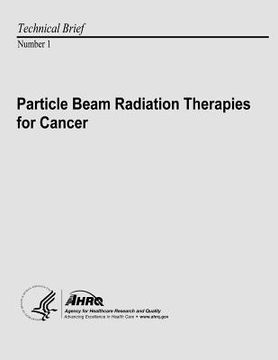Compartir
Particle Beam Radiation Therapies for Cancer: Technical Brief Number 1 (en Inglés)
U. S. Department of Heal Human Services
(Autor)
·
Agency for Healthcare Resea And Quality
(Autor)
·
Createspace Independent Publishing Platform
· Tapa Blanda
Particle Beam Radiation Therapies for Cancer: Technical Brief Number 1 (en Inglés) - And Quality, Agency for Healthcare Resea ; Human Services, U. S. Department of Heal
$ 15.99
$ 19.99
Ahorras: $ 4.00
Elige la lista en la que quieres agregar tu producto o crea una nueva lista
✓ Producto agregado correctamente a la lista de deseos.
Ir a Mis ListasSe enviará desde nuestra bodega entre el
Viernes 05 de Julio y el
Lunes 08 de Julio.
Lo recibirás en cualquier lugar de Estados Unidos entre 1 y 3 días hábiles luego del envío.
Reseña del libro "Particle Beam Radiation Therapies for Cancer: Technical Brief Number 1 (en Inglés)"
Radiotherapy with charged particles can potentially deliver maximal doses while minimizing irradiation of surrounding tissues. It may be more effective or less harmful than other forms of radiotherapy for some cancers. The aim of this Technical Brief was to survey the evidence on particle beam radiotherapy. Most types of cancer radiotherapy use ionizing photon (X-ray or gamma-ray) beams for the local or regional treatment of disease. Ionizing radiation damages the DNA of tumor and healthy cells alike, triggering complex biochemical reactions and eventually resulting in prolonged abnormal cell function and cellular death. Ionizing radiation is harmful to all tissues, malignant or healthy. In clinical practice, lethal tumor doses are not always achievable because of radiation-induced morbidity to normal tissues. Radiation therapists aim to maximize dose (and damage) to the target tumor and minimize radiation-induced morbidity to adjacent healthy tissues. This is generally achieved by targeting the beam to the tumor area through paths that spare nearby critical and radiosensitive anatomic structures; selecting multiple fields that cross in the tumor area through different paths, to avoid overexposing the same healthy tissues; and by partitioning the total dose in fractions (small amounts) over successive sessions. Because healthy tissues recover better and faster than malignant ones, with each radiotherapy session the accumulated cellular damage in the targeted tumor increases, while normal tissues are given the opportunity to repair. An alternative treatment modality is charged particle radiotherapy, which uses beams of protons or other charged particles such as helium, carbon or other ions instead of photons. They deposit most of their energy in the last final millimeters of their trajectory. This results in a sharp and localized peak of dose, known as the Bragg peak. The initial energy of the charged particles determines how deep in the body the Bragg peak will form. The intensity of the beam determines the dose that will be deposited to the tissues. By adjusting the energy of the charged particles and by adjusting the intensity of the beam one can deliver prespecified doses anywhere in the patient's body with high precision. As with photon therapy, the biological effects of charged particle beams increase with radiation dose. Because charged particles interact with tissues in different ways than photons, the same amount of radiation can have more pronounced biologic effects when delivered as charged particles. The Agency for Healthcare Research and Quality (AHRQ) requested a Technical Brief on the role of particle beam radiotherapy for the treatment of cancer conditions. Key Questions include: KQ1: 1.a. What are the different particle beam radiation therapies that have been proposed to be used on cancer? 1.b. What are the theoretical advantages and disadvantages of these therapies compared to other radiation therapies that are currently used for cancer treatment? 1.c. What are the potential safety issues and harms of the use of particle beam radiation therapy? KQ2: 2.a. What instrumentation is needed for particle beam radiation and what is the Food and Drug Administration (FDA) status of this instrumentation? 2.b. What is an estimate of the number of hospitals that currently have the instrumentation or are planning to build instrumentation for these therapies in the US? 2.c. What instrumentation technologies are in development? KQ3: Perform a systematic literature scan on studies on the use and safety of these therapies in cancer, with a synthesis of the following variables: 3.a. Type of cancer and patient eligibility criteria 3.b. Type of radiation, instrumentation and algorithms used 3.c. Study design and size 3.d. Comparator used in comparative studies. 3.e. Length of followup 3.f. Concurrent or prior treatments 3.g. Outcomes measured 3.h. Adverse events, harms and safety issues reported
- 0% (0)
- 0% (0)
- 0% (0)
- 0% (0)
- 0% (0)
Todos los libros de nuestro catálogo son Originales.
El libro está escrito en Inglés.
La encuadernación de esta edición es Tapa Blanda.
✓ Producto agregado correctamente al carro, Ir a Pagar.

